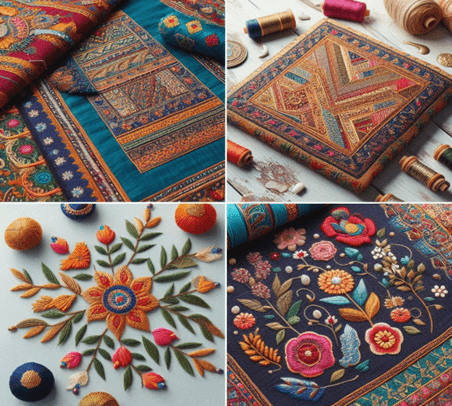The Art of Indian Embroidery: Zardozi, Kantha, and Phulkari
- indigenousartsfoundation
- May 24, 2024

t
ndian embroidery is a piece of art made with colorful threads and exquisite skill, with each stitch telling a tale full of cultural history. Zardozi, Kantha, and Phulkari embroidery stands out among the many other embroidery styles due to their distinctive techniques, lengthy histories, and elaborate patterns. In this blog you will explore the rich and varied world of these age-old creations of art to appreciate its significance and beauty.
Zardozi: The Royal Embroidery
- A Glimpse into History
The name “zardozi,” which is a combination of the Persian words “zar,” which means gold, and “dozi,” which means needlework, originated in the lavish courts of the Mughal Empire. Traditionally, gold and silver threads were used for this rich type of embroidery, which was frequently adorned with beads, pearls, and valuable stones. It adorned wall hangings, ceremonial robes, royal clothes, and even the gear of horses and elephants.
- The Craftsmanship
Zardozi, a traditional Persian garment, is created using a hooked needle, ‘aari’, to create intricate patterns on silk, velvet, or satin. Today, metallic wires and synthetic threads continue to make Zardozi accessible to a wider audience.
- Modern Relevance
Zardozi, a timeless fashion brand, combines elegance and royalty in bridal wear, formal attire, and home décor, with designers constantly innovating and blending contemporary aesthetics with classical motifs.
Kantha: The Storytelling Stitches
- Origins and Evolution
Bangladesh and West Bengal’s rural areas are the origin of kantha embroidery. It originated historically from the creativity of village women who piled wasted saris and dhotis to make blankets and pillows. These modest beginnings gave rise to a very expressive and useful art form.
- Technique and Patterns
Kantha, a traditional Indian art form, is a unique and intimate piece of art, crafted by artisans using simple running stitches and motifs inspired by daily life, folklore, and nature.
- Contemporary Kantha
Kantha, a traditional upcycling material, has evolved into a popular decorative art form used in fashion, home décor, and accessories, blending traditional values with modern trends.
“Indian embroidery is a living tradition, a vibrant thread that connects the past with the present through each intricate stitch.”
Phulkari: The Floral Magic
- Cultural Significance
Phulkari, which refers to “flower work,” is a traditional needlework form from Punjab that showcases the diverse cultural fabric of the area. It is typically a precious component of a Punjabi bride’s trousseau, carefully handmade by the household’s ladies. In festivities and customs, phalkari is regarded as a symbol of happiness, wealth, and heritage.
- The Artistry
Phulkari embroidery, a vibrant art form, uses floss silk threads on khaddar cotton fabric, creating a geometric pattern on the reverse side, creating a mesmerizing garden-like visual effect.
- Phulkari in the Modern World
Phulkari, a traditional Punjabi textile, has gained a resurgence in contemporary fashion and interior design, showcasing its vibrant spirit and artistic heritage globally.
- Preserving a Legacy
Embroidery in India is a living tradition that preserves communities’ stories, cultures, and identities. The modernization of Zardozi, Kantha, and Phulkari showcases their dynamic nature, ensuring their relevance in contemporary society. The artisans behind these intricate styles continue to keep the legacy alive, offering a glimpse into India’s rich cultural tapestry and preserving its rich heritage.






